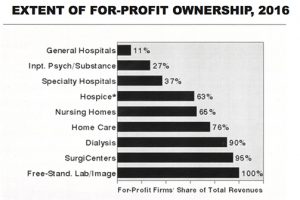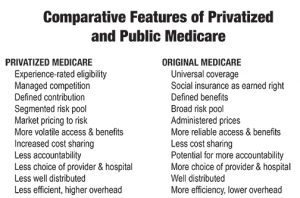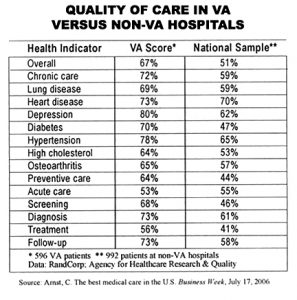Conservatives have long held that the free market can resolve system issues of access, costs, affordability and quality of health care. Long experience with privatized health care in this country, however, gives us solid evidence that privatization brings higher costs, less efficiency, less service, more bureaucracy, waste, and profiteering than not-for-profit public programs. Moreover, privatized companies and contractors keep coming back to the public till and taxpayers for more money as their inefficiencies mount. Despite all this, privatization of health care has been expanding and thriving under the Trump administration.
The extent of for-profit ownership of U. S. health care providers is much higher than many realize, as shown below.
Figure 1

Source: Commerce Department Service Annual Survey and MedPac, 2016
Adverse Consequences of Privatization
Let’s take a look at how the private sector has performed in five parts of our system compared to their not-for-profit counterparts.
Private insurers
Health insurers are increasingly dependent on government programs and subsidies for their growth. Over the ten-year period 2007 to 2017, Medicaid accounted for the largest increase in net premiums written growth, from $43 billion to $224 billion, while Medicare reported increases from $69 billion to $202 billion.
Medicare Advantage
- Federal audits of 37 Medicare advantage programs have found that they game the system to gain higher reimbursement by overstating risk scores for such conditions as diabetes and depression.
- Sicker people on Medicare Advantage commonly dis-enroll, typically citing restricted access to preferred physicians and hospitals or other medical care.
- A recent study in New York State found greater racial health disparities among patients hospitalized with Medicare Advantage compared to traditional Medicare, with black patients receiving worse post-hospital care resulting in higher readmission rates.
- Table 2 compares major differences between traditional Medicare and private Medicare Advantage.
Table 1

Source: Geyman J.P., Shredding the Social Contract: The Privatization of Medicare, Monroe ME, Common Courage Press, 2006, p. 206
Privatized Medicaid
- As with privatized Medicare, compared to their public counterparts, privatized Medicaid also has longer waits for care, inadequate physician networks, and denials of many treatments, even as the insurers take away higher profits.
- Privatized Medicaid programs have been shown to have worse outcomes than their public counterparts.
Nursing homes
- Two-thirds of the nation’s 16,000 nursing homes are for-profit, with more than one-half controlled by large corporate chains. They have been found to provide worse quality of care than not-for-profit nursing homes, typically by cutting nursing staffing to increase profits. When these profits are not sufficient, they often leave their communities.
Home Care
- For-profit home health agencies have higher costs and lower quality of care compared to their not-for-profit agencies.
Emergency Medical Services
- A 2016 investigate report by the New York Times documented that privatization of EMS, compared to public sector management, lowers quality of care, with slower response times, emphasis on profits rather than service, increased cost-cutting and hikes in prices.
Veterans Administration
The publicly administered VA has come under attack by many conservatives as they try to expand privatization of the VA based on the unproven ideology that veterans would have more choice and better care. The new private VA Choice program falsely claims that the private sector is more efficient than the VA, which remains underfunded despite serving increased numbers of veterans returning during and after 17 years of war. The evidence already shows that the traditional VA is more effective than VA Choice in these ways:
- Veterans often have to wait from 51 to 64 days to see a private physician, after which they may have to wait for months to discuss treatment options after an MRI of the neck and lower back.
- A majority of veterans have long been satisfied with their care at the VA, while such long-standing organizations as the American Legion and Veterans of Foreign Wars oppose privatization.)
- An earlier study by RAND and the Agency for Healthcare Research and Quality (AHRQ) has documented better quality of care in VA vs. non-VA hospitals, as shown below
Table 2

Conclusion
The forgoing shows that more privatization is not the answer to the nation’s problems of limited access, high and unaffordable costs, and unacceptable quality of care. Our health care system, the most expensive and inefficient in the world, is not sustainable and is in urgent need of fundamental reform, especially in the way it is financed, as subsequent blogs will discuss.
Adapted in part from my new recently released book, Trumpcare: Lies, Broken Promises, How it is Failing, And What Should Be Done
visit: http://www.johngeymanmd.org